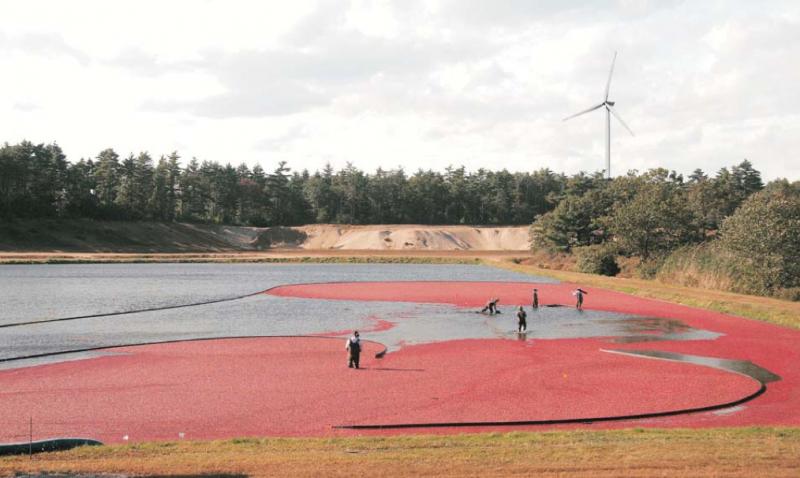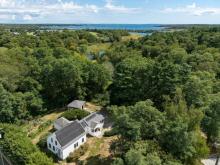Harvesting the wind, along with cranberries
Cranberry bogs in Wareham may be going high-tech. But the millions of dollars in new technology are not for harvesting cranberries but for harvesting the wind.
In a partnership among private cranberry bog owners in Wareham and wind developers from Beaufort Windpower LLC, of Boston, the Bog Wind Power Cooperative Project is hoping to construct eight wind turbines on five cranberry bogs beginning this December. The goal is to provide nearly 40 million kilowatt hours per year of electricity for Massachusetts (enough to power two-thirds of Wareham's households) and an alternative source of income for bog owners.
"It's a win-win type of thing," said Peter Beaton the owner of a bog where one of the turbines is to be situated. "It diversifies the farm, helping it weather economic cycles, and it seemed like the right thing to do with global warming and oil in other places."
The "Bogwind" business plan, however, is more complex than the typical wind development. In a presentation before the Board of Selectmen this Tuesday, Beaufort Windpower LLC Founder and President Glen Berkowitz described how he hoped to turn the challenges of wind development in Massachusetts - third most densely populated state, with few large tracts of open land, most of which do not have ideal wind resources - into positives.
"We've seen that some people have concerns about the way the turbines look, and if they live nearby, noise concerns and shadow flicker (the shadows cast by the spinning blades)," said Berkowitz before the meeting. "Furthermore, this land, is an important open space resource in town."
To address these concerns, the Berkowitz needed to emphasize partnership. Wareham cranberry farmers fit the bill. They have the open land, and the offshore breeze provides enough of a wind resource (although at a greater altitude than the turbines proposed for other areas, with total height being 492 feet from the ground to the tip of the highest blade which is twice the size of the turbine at Massachusetts Maritime Academy, for comparison) to make the project economical.
The town also fortuitously passed a zoning by-law to allow turbines. Finally, the bogs are connected to "robust power infrastructure," and have roads, according to Berkowitz, which enables access to the turbines for construction and maintenance, as well as enables power generated by the turbines to be effectively distributed.
In return for their cooperation, the bog owners receive annual lease payments, and Bogwind will make annual payments to the Cape Cod Cranberry Growers' Association.
However, spreading eight turbines among five parcels of land in a densely populated state means that there are many abutters. To gain their approval, Bogwind has hired Agricultural Land Manager Iain Ward to meet with abutting neighbors, as well as neighborhoods near the proposed turbines.
"Some people see hope in turbines, others don't want to see them at all," said Ward. If neighbors are objectionable, "we try to at least continue the discussion and try to educate them about the project."
So far, however, they have come up against surprisingly little resistance. They received no negative comments after they submitted their environmental notification form to the state, and they have enlisted the support of local and state environmental groups and worked with Town Conservation Agent David Pichette to be sure that their proposal wouldn't spark any environmental concerns.
They have also tried to be forthcoming with answers to questions and concerns about the sound and flickering shadows produced by the blades of the turbines.
"I have no concerns," said Jeff Hallahan, the owner of Garden Home Estates mobile-home park which is adjacent to a property with one of the proposed properties. "Having been involved in business for many years, I think that they are doing an exceptionally good job of going to talk with neighbors and address concerns beforehand. I don't see how it will affect homes, unless it's extremely noisy. But I went to Mass Maritime and had to be within 50 yards to hear the noise, and these turbines will be a third of a mile away.
Brian Mello, a resident of Blackmore Pond Road, said he and his wife had initial concerns about the size of the turbines, but now both support the project. He would like to have more information about the ambient noise that the turbines proposed for the area might produce, however .
[We're] all set to accept the visual impact, but we're concerned about the potential for it to be noisy," Mello said, explaining that he had found information about a low-frequency noise that turbines can produce. "At two or three o'clock in a summer morning when the windows are open, is this going to be an ambient noise?"
Mello said that Berkowitz had taken noise readings at the site, and found them to be within normal ranges, but he would like to see more information on decibel-readings during the night and early morning when there's no noise from the nearby highway traffic.
Like Hallahan, Mello commended Bogwind for its efforts in educating the community.
"They held an information session, and I think everybody walked out of there thinking that the man has a sincerity about him and was knowledgeable, truly committed to alternative energy, and a smart business man," Mello said. "He wasn't somebody cashing in on the sustainable energy thing du jour."
Mello said that he had heard of some concerns about noise among those on the opposite side of the pond but couldn't say if it was organized resistance.
But no matter how much land owners and abutters partner with Bogwind, the company needs a third partnership: financiers.
Berkowitz said that he has spoken with seven firms who are "absolutely interested" in co-developing the project, but that he cannot get commitments until the project is permitted.
He is not nervous, however.
"We're working on this project not because we're wealthy or in it just for the money," Berkowitz said. "We're doing this because we are passionately committed to local, green energy and diversifying income to family farms."
In his presentation to the Board of Selectmen, Berkowitz said he was amenable to further partnership with the town - mentioning everything from simply partnering with the town to purchase some of the power to also suggesting that, should the town want to erect its own turbine, it would be advantageous for both of them to coordinate their construction.
"Wareham could be the leading green community in Massachusetts with this project," Berkowitz said. "We need less photos of oil in the Gulf of Mexico or Buzzards Bay, and more photos of wind turbines sited in ways that are harmonious with neighborhoods and towns."














